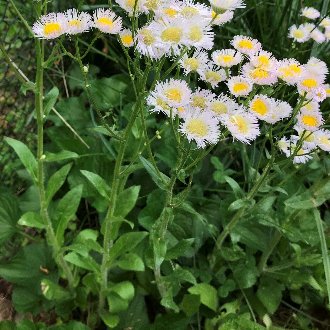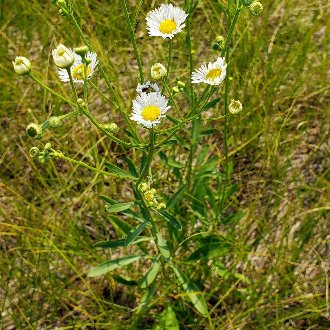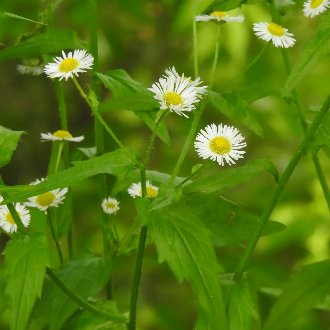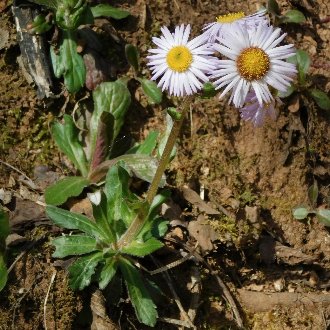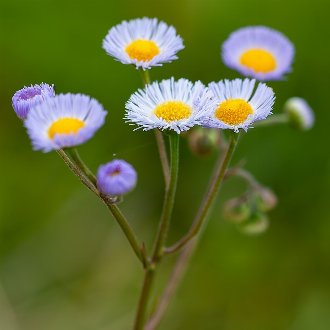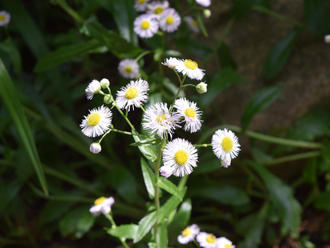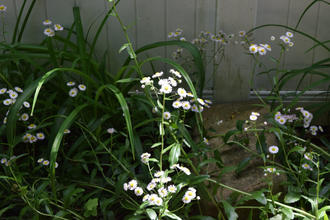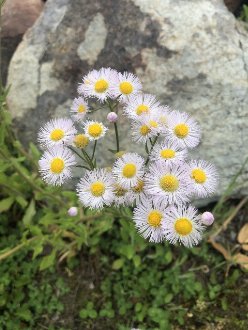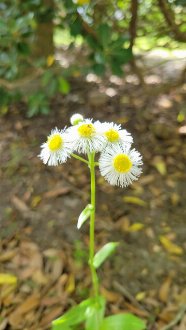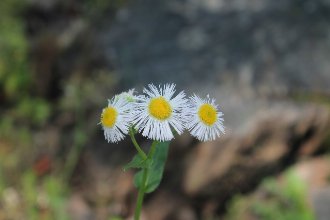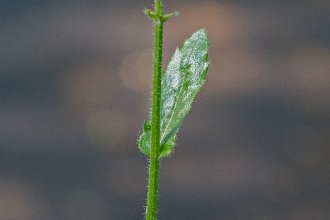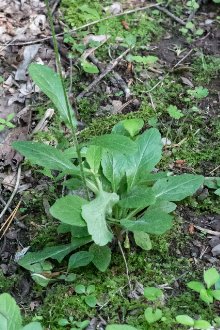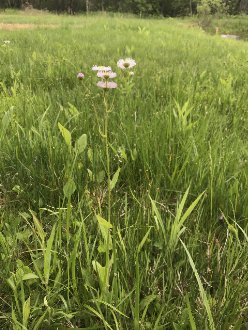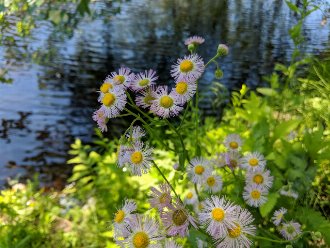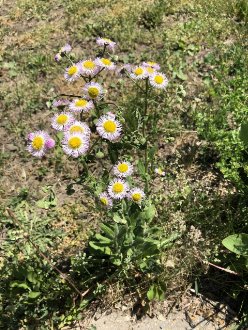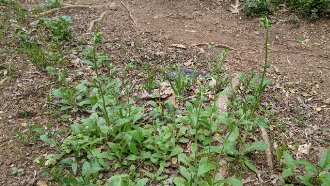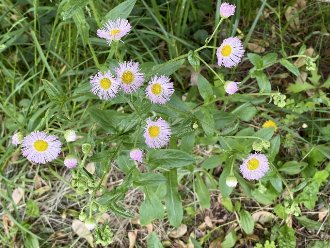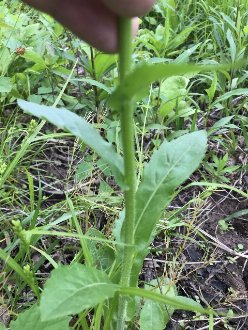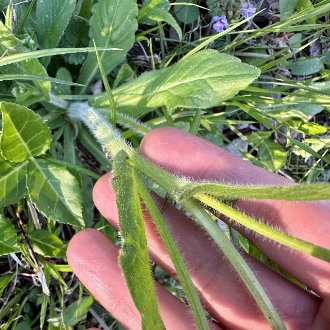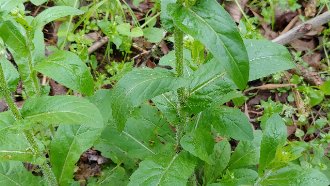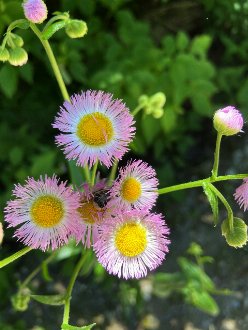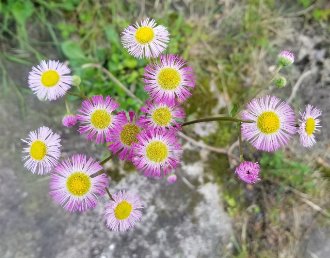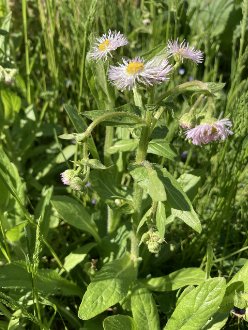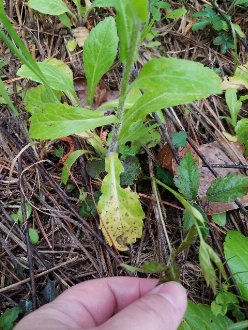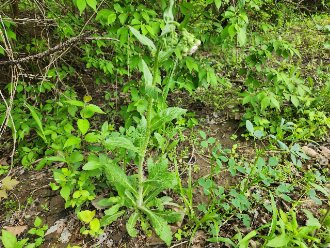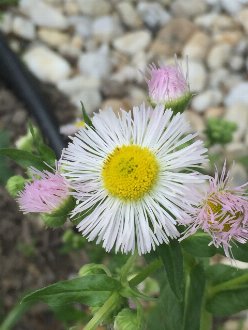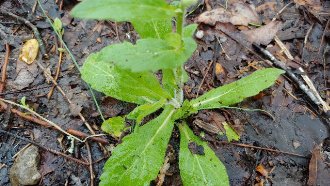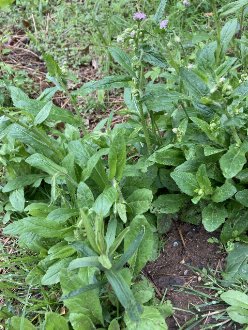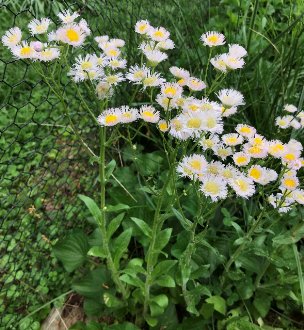Philadelphia Fleabane (Erigeron philadelphicus L.)
Also known as marsh fleabane, common fleabane.
↑Summary
A common and widely-distributed biennial or short-lived perennial of moist sites, native across North America.
↑Range - Expand
| Legend | Color |
| Native | |
| Native or Not Present |
This tentative map is based on our own research. It may have limited data on Canada and/or Mexico, and there is some subjectivity in our assignment of plants as introduced vs. expanded. Read more in this blog post.
Although this plant occurs somewhere in each of these regions, it may only occur in a small part of some or all of them.
↑Description & Identification
Philadelphia fleabane is usually relatively easy to distinguish from other Erigeron sp. by its narrow and numerous rays. Its clasping leaf bases distinguish it from some species. When its rays are not white, they tend to have a more reddish hue contrasting with the more bluish hue of other species.
Slightly less reliable but useful as a clue are its earlier average bloom time and preference for the moistest habitats among its genus.
↑Similar Plants
↑Habitat
Philadelphia fleabane is found in a variety of sunny to partly-sunny, moist, disturbed habitats with relatively rich soil of close to neutral pH. Natural habitats include depressions in black soil prairies, wet meadows, openings in floodplain forests, and sunny margins of ponds, lakes, and marshes. It frequently occurs in anthropogenic habitats, including ditches and moist depressions along roadsides and railroads, fallow fields, small woodland fragments in urban areas, suburban gardens, and low, wet areas in vacant lots and industrial waste ground.
This species is more common in the east to midwest and also across Canada; in the interior west of the US, it is uncommon to rare and scattered, although it becomes locally more common in more humid regions along the west coast. In the east it is often more abundant in anthropogenic habitats, and within its range it is often the most common fleabane in gardens.
It tolerates lighting conditions ranging from full sun to partial sun. It prefers nutrient-rich loamy soil, but tolerates more clayey soils or soils with some rocky material mixed in with fine-textured soils, if they are sufficiently fertile. This species prefers soil close to neutral (>= pH ~6.1), and is uncommon to absent on strongly acidic soils. It is more tolerant of slightly alkaline soils than some plants, which is reflected in it ranging farther west.
It is usually found in moist conditions, on sites that become waterlogged or shallowly flooded temporarily after rain. Within its range it is the fleabane most tolerant of flooding and poor drainage. It is rarely found on drier sites, and when it is, its size is greatly reduced.
This species is limited to habitats that experience significant disturbance, either natural or from humans, that removes vegetation and exposes some bare soil. Naturally, these disturbances are typically flooding or changing water levels along shorelines or in wetlands.
In the east, humans have greatly increased its habitat through irrigating gardens, enriching soil, and frequently disturbing habitats through mowing, weedwhacking, and herbicide use. It can survive in lawns but usually does not flower and set seed successfully in lawns that are mowed regularly. The more fragile populations in the interior west, however, have been threatened by habitat destruction and human activity.
↑Life Cycle
Philadelphia fleabane is usually a biennial or short-lived perennial.
The plant initially forms a basal rosette of leaves that stays close to the ground, often with the leaves pressed firmly against the ground, but sometimes slightly upright in a clump, especially under richer conditions, where the leaves grow larger. In spring, the plant bolts, growing a stem with alternate leaves which then flowers and sets seed. Although this species is usually among the earliest-blooming of the Erigeron species in its range (together with E. pulchellus), its bloom period is somewhat flexible, and a variety of conditions can lead plants to bloom later.
Sometimes, plants die after making seeds, but other times the basal rosette persists. Survival is more likely if the plant has both sufficient light and moisture. Death can be triggered both by drought and by shading from other plants.
This species usually depends on some sort of disturbance to persist, either natural or human induced, as in the absence of disturbance, the wet-but-not-persistently-flooded areas where it grows best will usually grow up with taller vegetation that will out-compete it. It benefits from sporadic mowing, and often seeds into wetter parts of lawns, where it sometimes persists as a basal rosette, but it usually cannot reproduce in a regularly-mowed lawn because it has insufficient time to flower and set seed.
Once established, the plant is more tolerant of competition from other plants than at germination, where its small seeds make it dependent on more exposed conditions.
Although it is infrequently reported in the literature, and occurs less frequently than on E. pulchellus, this species occasionally reproduces vegetatively through short rhizomes, forming small colonies. The rhizomatous habit can be induced by flowering stem being top-killed by herbivory or mowing, and can also occur when the plant is growing in favorable conditions.
↑Faunal Associations
The foliage and flowerheads are browsed by many different mammalian herbivores, both native ones including deer, rabbits, and groundhogs, and livestock including horses, cows, and sheep. Although the palatability to mammals is high, plants are protected somewhat by their basal leaves being pressed closely against the ground, with upright growth only occurring once other food sources are abundant.
The flowers attract a wide variety of small pollinators, including small carpenter bees (Ceratina sp.), cuckoo bees (Nomada sp.), mason bees (Osmia sp.), leaf-cutting cuckoo bees (Stelis sp.), blood bees (Sphecodes sp.), masked bees (Hylaeus sp.), mining bees (Adrenidae), two genera of potter wasps (Ancistrocerus and Stenodynerus), numerous flies, butterflies, skippers, beetles, and plant bugs. The aphid Uroleucon erigeronense specialize on this genus, and the aphid Uroleucon nigrotibium eats this and goldenrods (Solidago sp.) The plant is also eaten by the leaf-hopper Empoasca alboneura, and the red-spotted aster mirid (Polymerus basalis).
The larvae of two moths eat this plant: the obscure schinia moth (Schinia obscurata) which specializes on this genus, and the lynx flower moth (Schinia lynx
), which also feeds on camphorweed (Heterotheca subaxillaris).
↑Uses
Although only occasionally planted intentionally, this species is often appreciated by gardeners when it appears as a volunteer. It is valued for its attractive flowers and foliage, and being easy to grow. It can sometimes be aggressive in a garden setting, especially in the presence of mulching, weeding, soil enrichment, and irrigation, all of which it benefits from.
↑Related Plants
There are numerous (well over 175) Erigeron species native to North America, but most are rare with limited distributions. The most common overlapping species are annual fleabane (Erigeron annuus), which grows taller and is less likely to persist as a perennial, Robin's plantain (Erigeron pulchellus), a longer-lived perennial, and prairie fleabane (Erigeron strigosus), another biennial or short-lived perennial that prefers slightly drier conditions.
Visually more distinct but also overlapping is horseweed (Erigeron canadensis), an annual with narrower leaves and much smaller flowerheads.
All of these species are widely-distributed and overlap with large portions of this species' range.
↑Notes
Although the common name "Philadelphia fleabane" is slightly misleading, as this species has a very large range, coast-to-coast in North America, we prefer this name both because it is unambiguous and because it matches the scientific name. The next-most-commonly used alternative, "marsh fleabane", although it is descriptive of the fact that this species prefers moist habitats, is unfortunately also used to refer to the more distantly-related sweetscent (Pluchea odorata) which occurs primarily in salt marshes. The term "common fleabane", besides being less widely used, is also potentially ambiguous, and not particularly descriptive as the other species E. annuus and E. strigosus are also common in various parts of this species' range, and the name is also similar to the common name "common eastern fleabane" sometimes used to refer to E. strigosus.
↑Links & External Resources
• Erigeron philadelphicus (Philadelphia Fleabane) | Illinois Wildflowers (About This Site)
• Erigeron philadelphicus (Philadelphia Fleabane) | USDA PLANTS Database (About This Site)
• Erigeron philadelphicus | Go Botany (About This Site)
• Erigeron philadelphicus (Common Fleabane) | Missouri Botanical Garden Plant Finder (About This Site)
• Erigeron philadelphicus | Biota of North America Project (BONAP) (About This Site)
• Erigeron philadelphicus | NatureServe Explorer (About This Site)
• Erigeron philadelphicus | Flora of North America (About This Site)
• Erigeron philadelphicus | Missouri Plants (About This Site)
• Common Fleabane | Maryland Biodiversity Project (About This Site)
• Erigeron philadelphicus (Philadelphia Fleabane) | Minnesota Wildflowers (About This Site)
• Erigeron philadelphicus L. var. philadelphicus (Philadelphia Fleabane) | Digital Atlas of the Virginia Flora (About This Site)



